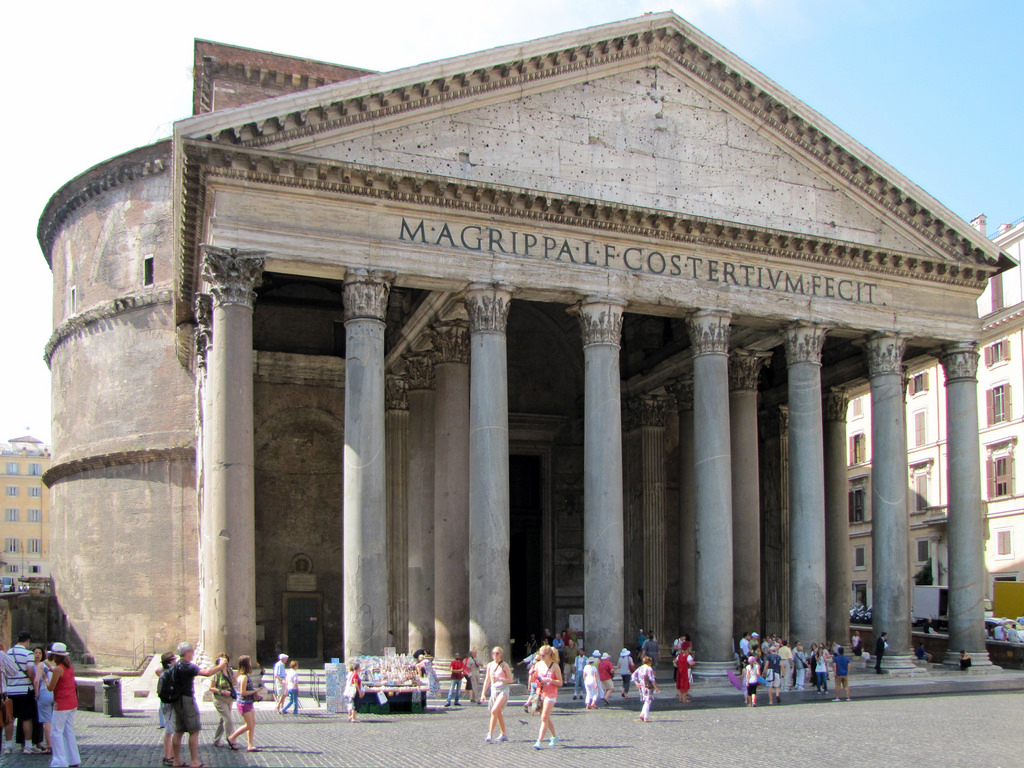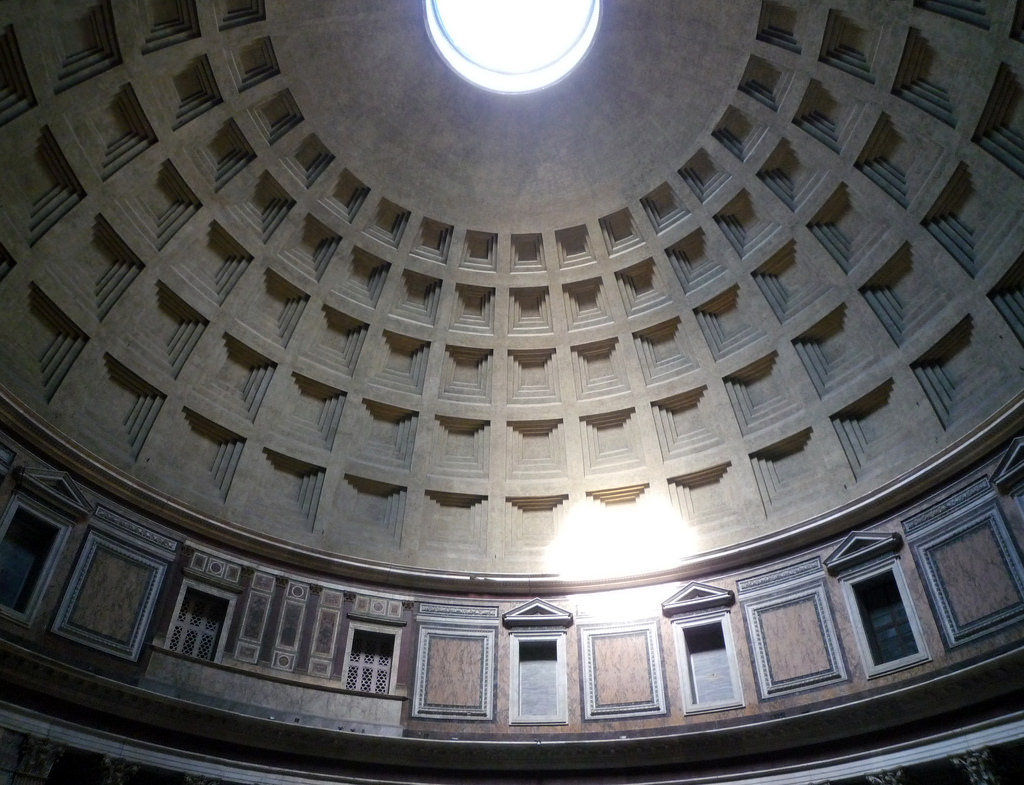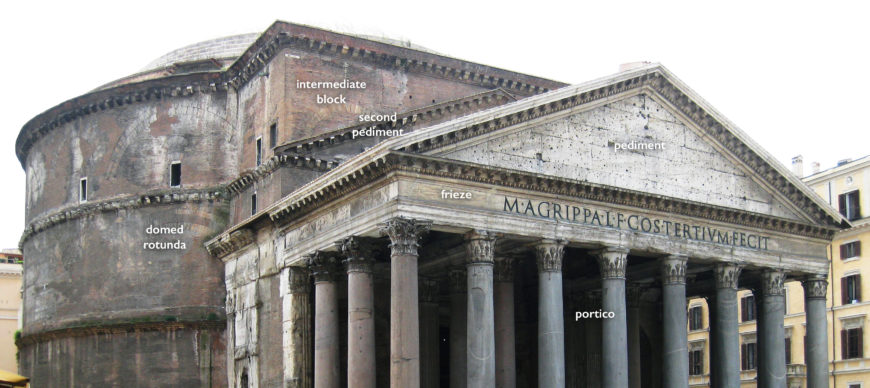3.2 Religion and Philosophy
The Pantheon
While the Pantheon’s importance is undeniable, there is a lot that is unknown. With new evidence and fresh interpretations coming to light in recent years, questions once thought settled have been reopened. Most textbooks and websites confidently date the building to Emperor Hadrian’s reign and describe its purpose as a temple to all the gods (from the Greek, pan = all, theos = gods), but some scholars now argue that these details are wrong and that our knowledge of other aspects of the building’s origin, construction, and meaning is less certain than we had thought.

It is an open question whether the building was ever a temple to all the gods, as its traditional name has long suggested to interpreters. Pantheon, or Pantheum in Latin, was more of a nickname than a formal title. One of the major written sources about the building’s origin is the Roman History by Cassius Dio, a late second- to early third-century historian who was twice Roman consul. His account, written a century after the Pantheon was completed, must be taken skeptically. However, he provides important evidence about the building’s purpose. He wrote,
He [Agrippa] completed the building called the Pantheon. It has this name, perhaps because it received among the images which decorated it the statues of many gods, including Mars and Venus; but my own opinion of the name is that, because of its vaulted roof, it resembles the heavens. Agrippa, for his part, wished to place a statue of Augustus there also and to bestow upon him the honor of having the structure named after him; but when Augustus wouldn’t accept either honor, he [Agrippa] placed in the temple itself a statue of the former [Julius] Caesar and in the ante-room statues of Augustus and himself. This was done not out of any rivalry or ambition on Agrippa’s part to make himself equal to Augustus, but from his hearty loyalty to him and his constant zeal for the public good.
A number of scholars have now suggested that the original Pantheon was not a temple in the usual sense of a god’s dwelling place. Instead, it may have been intended as a dynastic sanctuary, part of a ruler cult emerging around Augustus, with the original dedication being to Julius Caesar, the progenitor of the family line of Augustus and Agrippa and a revered ancestor who had been the first Roman deified by the Senate. Adding to the plausibility of this view is the fact that the site had sacred associations—tradition stating that it was the location of the apotheosis, or raising up to the heavens, of Romulus. Even more, the Pantheon was also aligned on axis, across a long stretch of open fields called the Campus Martius, with Augustus’ mausoleum, completed just a few years before the Pantheon. Agrippa’s building, then, was redolent with suggestions of the alliance of the gods and the rulers of Rome during a time when new religious ideas about ruler cults were taking shape.
By the fourth century C.E., when the historian Ammianus Marcellinus mentioned the Pantheon in his history of imperial Rome, statues of the Roman emperors occupied the rotunda’s niches. In Agrippa’s Pantheon, these spaces had been filled by statues of the gods. We also know that Hadrian held court in the Pantheon. Whatever its original purposes, the Pantheon by the time of Trajan and Hadrian was primarily associated with the power of the emperors and their divine authority.

The symbolism of the great dome adds weight to this interpretation. The dome’s coffers (inset panels) are divided into 28 sections, equaling the number of large columns below. 28 is a “perfect number,” a whole number whose summed factors equal it (thus, 1 + 2 + 4 + 7 + 14 = 28). Only four perfect numbers were known in antiquity (6, 28, 496, and 8128) and they were sometimes held—for instance, by Pythagoras and his followers—to have mystical, religious meaning in connection with the cosmos. Additionally, the oculus (open window) at the top of the dome was the interior’s only source of direct light. The sunbeam streaming through the oculus traced an ever-changing daily path across the wall and floor of the rotunda. Perhaps, then, the sunbeam marked solar and lunar events, or simply time. The idea fits nicely with Dio’s understanding of the dome as the canopy of the heavens and, by extension, of the rotunda itself as a microcosm of the Roman world beneath the starry heavens, with the emperor presiding over it all, ensuring the right order of the world.

Roman Philosophy
Just as Hellenistic philosophy developed in the long shadows cast by Plato and Aristotle, Roman philosophy also used these two giants of Greek philosophy as reference points. While Roman philosophical traditions were built upon their Greek forebearers, they developed in a Roman cultural context. Rome began as a republic before becoming an empire, and Roman philosophy was affected by this political transformation. Still, Roman philosophical schools were thoroughly grounded in Greek philosophy, with many Roman philosophers even choosing to write in Greek rather than Latin, since Greek was viewed as the language of scholarship.
Rhetoric and Persuasion in Politics
Recall that Plato defined philosophy in opposition to sophistry. Whereas the philosopher sought the truth in a dispassionate way using reason as a guide, the Sophist addressing a crowd was indifferent to truth, seeking power and influence by appealing to the audience’s emotions. This harsh critique of rhetoric, which can be defined as the art of spoken persuasion, softened with subsequent philosophers. Indeed, Aristotle wrote a text called Rhetoric in which he sought to analyze rhetoric as the counterpart to philosophy. The tension never disappears entirely, however, and the relationship between philosophy and rhetoric and, more generally, the relationship between philosophy and politics remains a perennial question.
Despite the fact that his ideal statesman was a philosopher, Plato generally sought to keep philosophy distinct from the grubbiness of real politics and was concerned about the messiness of democratic politics in particular. In the Roman political context, this ambivalence becomes less apparent. Examples of philosophers who were also statesmen include Cicero (106–43 BCE) and Marcus Aurelius (121–180 CE). Marcus Aurelius even served as emperor of Rome from 161 to 180 CE. However, as the Roman Republic gave way to the Roman Empire, philosophers shifted inward by focusing on things that were in their control.
Stoicism
Aristotle held that eudaimonia is worthwhile at least in part because it helps us to better deal with various inevitable misfortunes. The Roman Stoics further developed this idea, proposing four core virtues: courage, justice, temperance, and wisdom. The Stoics were wary of the type of false judgments that might arise from the emotions. They were also uneasy with the loss of control associated with strong emotions, observing that some people can become enslaved to their passions. The Stoics prized rational self-control above everything else. This constant work at maintaining inner freedom epitomizes the Stoic conception of philosophy (Hadot 2002).
The Stoics were systematic philosophers whose writings focused on ethics, physics, logic, rhetoric, and grammar. For the Stoics, the world consists of material bodies in motion, causally affecting each other. Real entities are those capable of causally affecting one another. The Stoic god is a material entity who exists in nature and meticulously manages it, the material first cause of the universe, Aristotle’s unmoved mover incarnated as a material entity. In other words, God is an animating reason that gives life to the universe. Unlike the Christian God who transcends the universe, the Stoic god is found within it, a force immanent to the universe who combines and recombines the four elements into things we can experience because they act upon us and we upon them. Stoicism developed at a time when politics in the Roman world was increasingly seen as something outside individuals’ power to change. So Stoics let politics go. While turning away from politics may indeed promote a tranquil life, it also promotes passivity. Thus, Stoicism reached a conclusion similar to that reached by Daoism, as explored in the chapter on early philosophy.
Academic Skepticism
Academic Skepticism is another aspect of Roman philosophy that developed out of a tendency found in earlier Greek thought. Recall that Socrates questioned whether we could ever know anything at all. The Academic Skeptics opposed the Stoic claims that sense impressions could yield true knowledge, holding instead that knowledge is impossible. Instead of knowledge, Academic Skeptics articulated the idea of degrees of belief. Things are more or less believable based on various criteria, and this degree of believability is the basis for judgment and action. Disciples of the Greek philosopher Pyrrho (c. 360–270 BCE) held that we had to suspend judgment when it comes to knowledge claims, going so far as to say that we cannot even reliably claim that we cannot know anything. Rather than suspending all judgment, Academic Skeptics sought to demonstrate that knowledge claims lead us to paradoxical conclusions and that one can argue cogently both for and against the same proposition.
The philosopher, orator, and statesman Cicero (106–43 BCE) was the most prominent of the Academic Skeptics. His works provide much of the information we have about the school. He had a decisive influence on Latin style and grammar and was decisive in the introduction of Hellenistic philosophy into Rome. The rediscovery of his work in the 15th century ushered in the European Renaissance.
Neoplatonism
Plotinus (c. 204–270) led a revival of Plato’s thought in the late Roman Empire that lasted until Emperor Justinian closed Plato’s Academy in 529. Plotinus believed that he was simply an expositor of Plato’s work, but the philosophy he developed, known as Neoplatonism, expanded on Plato’s idea. Neoplatonism arose during a time of cultural ferment in the Roman Empire, incorporating ideas borrowed from sources such as Judaism and early Christianity. The key metaphysical problem in Neoplatonism was accounting for how a perfect God could create a universe that was manifestly imperfect. Plotinus solved this problem by applying ideas similar to Plato’s theory of forms. The perfect, unchanging realm is the one inhabited by God, but creation inhabits the changing realm, which only mirrors forms imperfectly. Plotinus claims that creation emanates from God, but the further one is from this source the less perfect things become.

